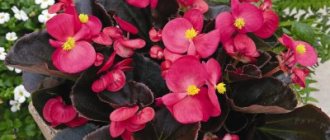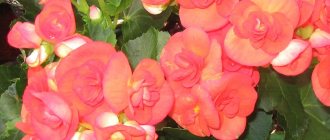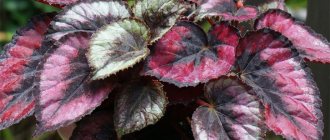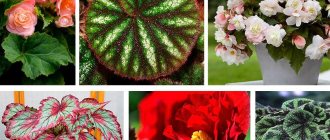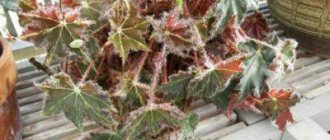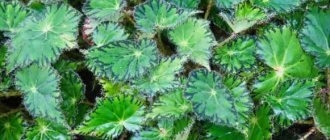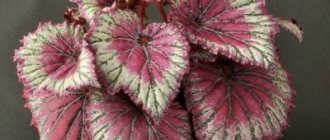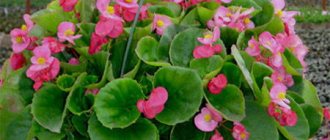Currently, many varieties of ever-flowering begonia have been bred, including those resistant to the temperature conditions of the cool summer of the middle zone.
Such varieties are cultivated as annuals , grown indoors and then planted outdoors in the spring, once the threat of frost has passed.
When the autumn cold snaps, the plants are removed.
Well-preserved strong specimens, which will serve as a source of cuttings for the growth of the next summer season, are sent for a warm winter.
- The following varieties of ever-flowering begonia are most suitable for such cultivation:
- Alba is tall, up to 40 cm, spreading, with dark green foliage and white flowers, collected in groups of 12 pieces.
- Kate Teicher - grows to a height of 40 cm, green leaves edged with red. The inflorescences are red, thirteen-flowered.
- Carmen is a medium-growing (25 cm) variety with very dark, lilac-brown foliage and pink flowers clustered in groups of six.
- Othello - 25 cm stems bear bright scarlet flowers that bloom in abundance.
- Albert Martin is a low-growing (15 cm) variety, green leaves with a red edge. Bright carmine-purple flowers are united in inflorescences of nine pieces. Up to 55 flowers unfold simultaneously on one plant.
- Bella is low (19 cm), decorated with green leaves bordered by red and dark pink nine-flowered inflorescences. 140 flowers can bloom at the same time.
- Bicola is a low-growing (13 cm) variety with green foliage and white flowers edged with pink, in clusters of four.
At the same time, even more numerous “ever-flowering” varieties are grown indoors .
Description
Semperflorence belongs to the Begoniaceae family . The natural habitat of the flower is Bolivia, Brazil and the northern regions of Argentina.
In begonia's usual habitat, the length of the shoots is usually in the range from 0.1 to 0.7 m; in culture it can reach a meter in length.
Interesting! The main selection is aimed at breeding low-growing varieties suitable for long-term indoor cultivation.
The begonia semperflorens bush is formed by a large number of shoots branching from the very base.
The shoots, like the leaf petioles and veins on the back of the leaf blades, have a distinct reddish tint. The leaf blades are fleshy, round, with a pronounced sharp tip and jagged edge.
Usually rich green, but hybrid varieties boast a wider palette :
- bronze shade;
- chocolate;
- with a burgundy tint;
- with shades of red.
Flowers (male and female) are collected in loose racemes. The color of the petals is very diverse - from white-pink to coral. Flower growers especially value terry begonia with bright red corollas .
Forum, reviews
Elena writes: “This is my favorite indoor flower. My begonia blooms almost all year round, it’s definitely “ever-blooming”! The most tedious thing is to remove faded inflorescences. In the spring I trim my beauty by two-thirds. I feed with water infused with banana peels—a source of potassium and phosphorus.”
Igor writes: “It is best to root cuttings by sticking them into damp moss and covering the top with a jar.”
Irina writes: “I bought seeds of terry begonia ever-blooming. When the seedlings bloomed, the flowers were small, not double, white and yellow, I thought the doubleness would appear later. After reading the article, I realized it won’t appear.”
Varieties of evergreen begonia
Semperflorence is divided into three groups according to the height of its shoots.
Tall
The height of such plants is about 0.4 m and above . Tall begonias are distinguished by large leaf blades and equally large flower cups (some fully opened buds can reach 60 mm in diameter).
Medium height
Medium-sized plants include bushes whose height does not exceed 0.3 m . The size of the leaf blades of such bushes is noticeably smaller than that of tall varieties, and the flowers are smaller.
Low-growing or dwarf varieties
The height of such bushes does not reach 0.2 m . The leaves and flowers are quite small, but such flowers have a higher adaptive capacity than their taller counterparts.
Dwarf begonias look great both in open ground and in flowerpots and pots.
Popular varieties with photos
Among the huge number of hybrid varieties, every gardener will be able to choose an interesting specimen for himself. The most popular are begonias.
Alba
This begonia can often be found in a flower bed. Its tall (up to 0.45 m) spreading bush looks good in ridges and flower beds.
Begonia is grown as an annual and is renewed annually, since the plant gives large (up to half a meter) annual growth.
It is distinguished by the rich dark green color of the leaves with a light waxy coating and large white flowers, collected in brushes of 14 pieces.
Albert Martin
Belongs to the dwarf varieties of ever-flowering begonia. It has small, dense green leaves with a pronounced reddish border along the edge and small flowers of a bright purple hue, collected in brushes of 9 pieces.
Ambassador F1
A medium-sized hybrid that unites a series with a noticeable red border along the edge of the petals. Easy to care for and resistant to adverse factors.
Bada boom F1
A medium-sized variety with a bush height of up to 0.25 m. The plant is noteworthy for its leaf blades with a pronounced bronze tint.
Bella
A low begonia with a shoot height of about 19 cm. This variety attracts the attention of flower growers with its lush flowering, because almost one and a half hundred flowers can bloom on a bush at the same time.
Bicola
A dwarf variety with very beautiful and vibrant flowering. The flower petals are painted in a light, almost perfect white tone with a red stripe along the edge.
Bowshin
The variety grows from 0.2 to 0.4 m in height. Attracts attention with the bright pink flowering of small corollas, with which the bush is densely strewn.
Havana scarlett
An attractive low-growing variety up to 0.2 m high with bronze foliage and red flower petals.
Galla lilu F1
The size of the hybrid is up to 0.2 m, but the bush attracts attention with light shading on the leaves and bright red-pink corollas.
Emperor red F1
The hybrid grows up to 30 cm. It has a large number of shoots with rather large single red flowers.
Begonia cocktail
It is distinguished by a pronounced bronze tint of the leaves, which creates a bright contrast with the light tone of the petals.
Carmen
Medium-sized variety with highly decorative dark brown leaf blades. The background of the leaves perfectly sets off the light color of the flower petals.
Kate Teicher
A tall variety with high decorative qualities. Its large, richly colored foliage and bright scarlet flowers also attract attention to the plant.
Queen F1
A low bush up to 0.2 m tall with rich green leaf blades differs from other ever-blooming begonias in its densely double flowers. The color of the petals can be:
- white;
- pink, both light pink and rich shade;
- red.
Begonia lotto
Belongs to medium-sized varieties. The color of the petals can be either white or deep red or pink.
Lucenets F1
A dwarf hybrid with a very interesting double color of petals. On a soft white background, a bright pink or crimson border is clearly visible.
Magma F1
A very attractive dwarf hybrid that requires virtually no care. It is distinguished by its rich chocolate color of leaves and bright red flower petals.
Olomouc F1
Dwarf hybrid, one of the most famous. It is distinguished by the milky white color of the petals and vigorous flowering.
Othello
The height of the bush rarely exceeds 0.2 m. The plant is notable for the fact that it easily forms into a ball, densely dotted with small scarlet flowers.
Begonia senator
It is considered one of the best hybrids with abundant branching, a large number of bronze leaves and an incredible number of small flowers collected in racemes.
Sprint plus F1
Hybrid series. Flower petals can be colored pink, red or white. The size of the plant is small, only up to 0.25 m.
Stara F1
A large variety whose height can reach up to half a meter. The leaf blades are a rich reddish-green hue, and the large beautiful flowers are white or pink.
Vision F1
A medium-sized hybrid with leaves of a rich dark green hue. Large flowers can be white, pink, red or coral.
Fiona F1
A low plant up to 0.2 m in height has strong, well-branched shoots, small leaf blades with a uniform green color and bright red-pink double and semi-double flower petals.
Planting in open ground
The exotic, whose homeland is equatorial countries, will not survive the harsh Russian winter. Therefore, the flowerbed will have to be updated every year . But what an opportunity to see a variety of varieties of evergreen begonia!
Deadlines
Already grown seedlings are planted in the ground . The optimal planting time will be mid-May, when the soil has already warmed up sufficiently and the threat of recurrent night frosts has completely passed.
Selecting a location
In order for semperflorence to bloom profusely and beautifully all summer, attracting attention, you need to choose the right place on the site .
Attention! Although the everblooming begonia is native to the warmer regions of America, direct sunlight falling on the flower all day can cause burns on the delicate leaves.
You should not plant seedlings in dense shade either: such conditions will cause the sprouts to stretch out, and the flowering will be faded and indistinct.
Give preference to areas where the bright sun will illuminate the plantings before noon and after five o'clock in the evening , and in the midday heat they will be shaded.
Soil preparation
Begonia prefers loose, nutritious soil . Before planting seedlings in the ground, it is important to disinfect the soil by spilling it with a solution of potassium permanganate.
Attention! Be sure to lay a drainage layer before planting flowers. Prolonged contact of roots with moisture will lead to plant rotting.
If the soil on the site is too heavy and lumpy, it should be loosened by adding peat and calcined river sand.
Landing
Thanks to the variety of colors and sizes of plants, gardeners create incredible compositions in flower beds of ever-flowering begonias.
Prepare holes for planting seedlings:
- Pebbles or crushed bricks are placed at the bottom of each to ensure good drainage.
- It is good to add a layer of rotted compost on top: this will provide the flowers with nutrients.
- The holes are dug at a distance of at least 10 cm from each other so as not to thicken the plantings.
- The sprouts should fit freely in the hole so that the roots can be easily straightened.
- There is no need to deepen the plant too much; the root collar should be above the surface of the ground.
Reproduction
Cuttings
Propagation by cuttings allows you to preserve the main characteristics of the variety. It is best to carry it out at the end of March-April.
- Cut off part of a healthy shoot (10-12 cm). It should have 2-3 buds, but no more. Pinch off excess leaves so that they do not take away nutrients.
- Keep the cutting in the fresh air for several hours. As soon as the juice stops flowing, plant it in a glass with soil and place it in a warm, bright place. Some gardeners propagate by cuttings in water, but in such conditions the cuttings often rot. It is not necessary to use root formation stimulants: begonia is ever-flowering and gives roots so quickly.
- Cover the glass with film (or glass, or a plastic bottle), ventilate and water regularly. When the roots appear, plant them in the prepared pot.
Growing from seeds
- Mix humus, leaf soil and sand in a ratio of 2:1:1 (or buy Begonia soil), plant the seeds without deepening them into the soil. The time for landing is December-January.
- Moisten the soil and cover the container with clear glass or polyethylene. Maintain the temperature within +20-22 degrees. Water not from a glass, but through a tray or using a spray bottle. Do not allow condensation to form on the walls.
- When 2-3 leaves appear on the sprouts, the seedlings are picked into separate containers.
Outdoor care
Caring for semperflorence in a flower bed is not difficult, but you should still follow the basic recommendations in order to admire the abundant flowering.
Watering
The soil around the bushes should always be slightly damp.
Important! Do not allow the soil to dry out: this will lead to the death of the flowers.
When watering, try not to let water get on the leaf blades . Often such an oversight leads to rotting of the leaves.
Water the ever-flowering begonia with settled warm water early in the morning or after sunset.
Feeding
To maintain flowering, for flowering plants are regularly applied along with watering The frequency of fertilizing should not exceed 1 time in 14 days.
Wintering
To preserve the plant, with the onset of autumn, the bush is dug out of the flowerbed and transplanted into a pot . Such a plant can be kept in the house during the winter and then planted again in the flowerbed in the spring.
If it is not possible to keep the plant in an apartment, then the pot with begonia can be stored in a room with an air temperature of at least 10 ° C.
New shoots when stored in this way need to be regularly pinched until the onset of spring.
Planting and care at home
to grow ever-flowering begonia at home from seeds . To do this, prepare low (up to 150 mm) wide containers, fill the bottom with a drainage layer and select a loose, slightly acidic substrate.
You can use ready-made soil intended for begonias. The seeds are distributed over the surface, moistened and placed in containers with crops in a warm, well-lit place.
Lighting and temperature
For the full development of home semperflorens, you will need a lot of bright, but diffused light .
It is optimal to place a pot of ever-flowering begonia on an east or west window. If the flower is on the south window, then it must be shaded at midday.
Begonia is tolerant of high temperatures and easily tolerates even extreme heat , of course, provided that the soil is properly moistened.
But low temperatures combined with drafts can destroy a flower in a very short time.
Watering and air humidity
The optimal air humidity for keeping semperflorence is 50% .
Important! Ever-blooming begonia does not tolerate spraying. Water that gets on the leaves can cause unsightly spots and rot.
It is optimal to use water trays or automatic humidifiers for humidification.
You need to water the flower often, in small portions; the ground should always be slightly damp . But under no circumstances should you allow moisture to stagnate in the pot.
Feeding
The flower needs active feeding during the period of spring growth of green mass and in summer. At this time, fertilizing is applied along with watering once every two weeks. In autumn, the frequency of fertilizing is reduced to 1 time per month; In winter they can be canceled altogether.
To maintain the strength of semperflorence, ready-made mineral complexes are used.
Trimming
Most ever-flowering begonias do not require pruning or bush formation . It is enough just to pinch off excessively elongated shoots and from time to time remove undiscarded wilted buds.
Interesting! Semperflorence has the ability to self-clean, so it is necessary to forcibly remove wilted buds only in rare cases.
Transplants
Only young plants need regular replanting . Adult bushes undergo only partial soil renewal.
Wintering on the windowsill
Semperflorence can overwinter in two ways:
- Cut off the entire above-ground part and place the pot in a cool, dark place until spring.
- Leave the flower in the same condition as it grew over the summer. By the time winter sets in, the temperature in the room is reduced to 15 °C, the amount of watering is reduced, and fertilizing is completely canceled until spring.
Transfer
Selection of container and soil
The root system of begonias grows horizontally, so it is better to select wide, but not deep, pots for replanting; the diameter should exceed the depth. It is better to select pots from ceramics. Clay protects well from waterlogging, has thermal insulation properties, and is breathable.
Important! When planting tall varieties of begonia, you need to take care of supports for the fragile stem and weighting the pot so that it does not tip over under the weight of the flowering plant.
A good substrate for a flower: light, loose, moisture-permeable, water-permeable. You can buy special soil for begonias in the store. Begonia everblooming will grow well if planted in ordinary garden soil, adding sand or vermiculite. You can make a special substrate yourself:
- leaf soil—2 parts;
- peat—2 parts;
- sand—1 part;
- compost—1 part;
- a handful of vermiculite.
The acidity of the soil should be within the pH range of 5.5-6.5; if necessary, add dolomite flour.
Planting begonias in another pot
Flower transplantation is done in the following sequence:
- The prepared soil is disinfected.
- A layer of pebbles or expanded clay is placed at the bottom of the pot, and a layer of substrate is placed on top.
- Before transplanting, water the begonia thoroughly and let it stand.
- Shake off old soil from the roots, inspect the root system, remove diseased roots.
- Place the bush in a pot without deepening the root collar.
- Sprinkle soil on top.
- If after watering some of the roots are exposed, add soil.
Care errors
Flower growers often encounter problems caused by mistakes in caring for ever-flowering begonias.
Frequency problems:
- Dry leaves . The reason is too dry air or insufficient watering.
- The appearance of rot on a bush can be caused by low temperatures combined with excessive moisture.
- The leaves turned yellow and began to fly off . The reason is too low temperature and high humidity.
- The leaves have lost their color intensity - the flower does not have enough sunlight.
- Lack of flowering can be caused by low temperature, drafts, or excessive amounts of fertilizer. A pot that is too large or unsuitable soil can also cause harm.
Read about other annuals:
Petunia Gioconda multiflorum: flower carpet
Brachycoma – 11 varieties bloom all summer
Common problems and their solutions
The main mistakes in plant care are stagnation of moisture or insufficient watering. Pale leaves and elongated shoots indicate insufficient lighting. If the flower does not bloom actively enough, you need to remove it from the south window, stop nitrogen fertilizing, increasing the proportion of phosphorus in the fertilizer.
Important! A plant dropping buds and flowers indicates insufficient room humidity or sudden changes in temperature and humidity.
Sometimes the edges of begonia leaves darken. This usually occurs when there is insufficient air humidity. Blackening of leaves and shoots indicates freezing of the plant. This can happen when leaves touch a cold window during severe frosts.
Evergreen begonia leaves turn black and dry
Combination with other plants
When kept indoors, evergreen begonia is tolerant of other indoor plants.
In a flowerbed, the flower goes well with ground cover plants . Semperflorence looks good next to alyssum, verbena, and cineraria.
Growing everblooming begonia is easier than it seems. Even a novice gardener can do this plant.
Beneficial features
The spectacular everblooming begonia is also a useful plant. It is capable of releasing special substances into the air - phytoncides, which actively destroy pathogenic microorganisms. Phytoncides are capable of completely destroying staphylococcus, while they reduce the total concentration of pathogenic bacteria by almost 80 percent. This is what helps the plant strengthen the immune system and improve performance.
Begonia ever-blooming: cultivation and care
